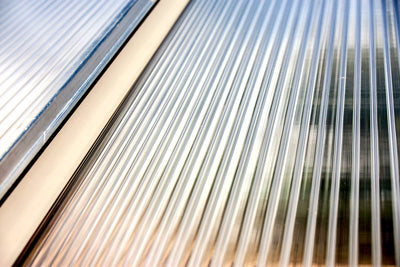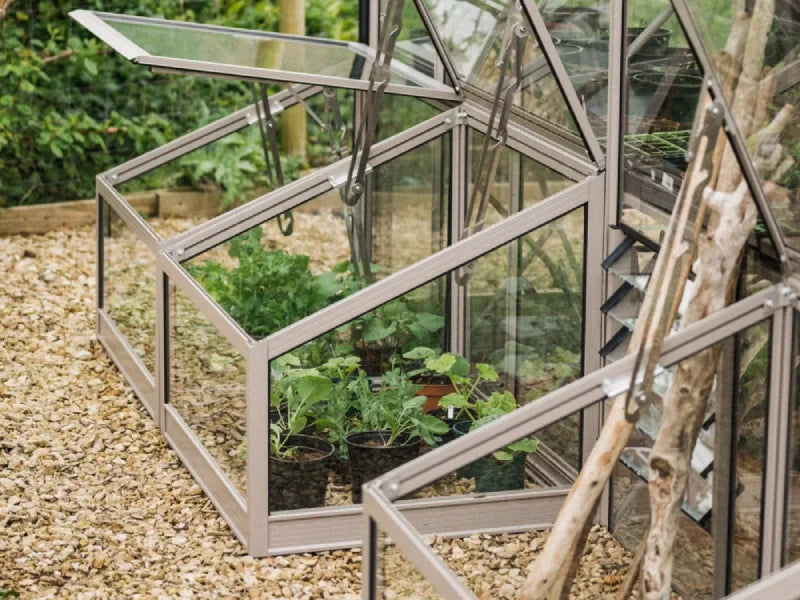Greenhouse Glazing - What are my options?
It will come as no surprise that the glass in a greenhouse plays a huge role in how safe and effective your greenhouse is. With glass being the primary component of your greenhouse, you must choose your glazing style carefully when purchasing.
Normal Glazing vs Toughened Glazing - What’s the Difference?
Not all glass is created equal and there are several types of glazing that you can choose from when it comes to your greenhouse, listed below are three of the most common:
1. HORTICULTURAL GLASS
The standard greenhouse glazing offered by most brands is 3mm horticultural glass. This type of glass has long been the traditional type of glazing used in greenhouses thanks to its low cost. That low cost does come with several red flags however, as horticultural glass is relatively weak and shatters easily, which causes genuine safety concerns.
As a general rule, horticultural glazing is the same no matter what make and model of greenhouse you have. The individual panes supplied measure 2ft x 2ft, overlap mid-way on each section of the greenhouse and are then held together with "S" or “W” clips. Multiple clips are used to secure each pane into place - the more the better to protect against wind damage.

Image: S and W clips
The major disadvantage of 3mm horticultural glass is that when it breaks it forms into large, sharp shards. This can be very dangerous and so is not advisable for those with children or pets.

Image: Broken pane of horticultural glass (see below for comparison with Toughened Safety Glass)
It is also worth noting that cleaning greenhouses with 3mm horticultural glass can prove difficult, as dirt and algae gather in the joins where the two panes meet, meaning you can’t clean these areas as thoroughly.
Bar Capping is often used in conjunction with horticultural glass glazing systems because it offers greater protection from wind damage as well as providing a cleaner overall appearance by hiding the metal clips from view.

Image: Bar capping
2. POLYCARBONATE GLAZING

Twin wall polycarbonate has a distinct advantage over horticultural glass, as it offers increased insulation for your greenhouse, which is especially useful in the winter months. It does, however, suffer from three major disadvantages that may deter you from purchasing it:
- Polycarbonate is so lightweight that it makes the greenhouse vulnerable to wind damage, which is less than ideal in most areas of the UK. Panels can bow and pop out of the framework when put under pressure from the elements which is an irritation at best, and a danger at worst.
- Polycarbonate also reduces light levels inside the greenhouse, thanks to the corrugated texture of the material. Light levels will continue to reduce over time, as the plastic ages and discolours.
- Polycarbonate is difficult to clean. Applying pressure to the panels while scrubbing can cause them to pop out while the twin layer plastic can house bugs and mildew in between the panes that is nigh on impossible to remove. This leads to further reduced light levels and a less healthy growing environment.

Image: Close up on polycarbonate panel.
3. TOUGHENED SAFETY GLASS
If you are looking for safe and sturdy greenhouse glazing, then you should consider toughened safety glass like our Rhino Tuff 4mm glazing. Toughened glazing is recommended for longevity as well as safety, and is the best option for greenhouses in exposed locations such as island and coastal regions.
While toughened glass is usually around 3mm thick, our Rhino Tuff glass is even thicker. Rhino Tuff 4mm toughened safety glass is 33% thicker than most greenhouse glass and comes as standard with every Rhino greenhouse.
The thicker glazing is manufactured with safety in mind so when a pane does break, it breaks into thousands of tiny pieces, meaning there are no large sharp edges that could injure someone. Even the edges of the glass are rounded so that you don’t cut yourself during the installation of your greenhouse.
The thicker glass panes ensure that the overall integrity of your greenhouse is maintained, especially when combined with a robust frame. The large panes have no overlaps, which means easier cleaning and fewer drafts, unlike small horticultural glass panes with overlaps that tend to attract dirt and algae over time.
Take a look at this video which illustrates the difference in strength between horticultural glazing and Rhino Tuff glazing:
https://www.youtube.com/watch?v=JyRXtpcSk9E
Why Choose Rhino Toughened Greenhouse Glazing? - No More W Clips
Traditionally, greenhouses have been supplied with 3mm horticultural glass. It may be cheap but it isn’t safe, as it breaks easily. An improvement on this is standard toughened 3mm glass. But even standard toughened glass doesn’t come close to the strength and quality of our Rhino Tuff 4mm glass. Our toughened safety glass is 33% thicker than most other suppliers provide and comes as standard with every Rhino Greenhouse, meaning you can benefit from significantly stronger glazing than most.

To add to the robust 4mm thick glass, the unique Rhino glazing system locks each pane of glass in place along its entire length with the use of rubber glazing beads. This means that each pane becomes an integral part of the strength of the whole frame, in contrast to other greenhouses that use bar capping simply to conceal the usual ‘W’ clip as a cosmetic improvement. With Rhino glazing beads, the glass cannot be blown or sucked out of the frame and pushing on the glass only locks the beads more tightly into the frame. You won't find a better glazing system for its security and dependability - Rhino greenhouses can handle high winds and storms, no problem.
Because the rubber beading creates an airtight seal, you may also find that the greenhouse temperature is better regulated. It is much easier to insulate and retain heat when you don't have overlapping panes (like horticultural glass) or panels that flex in the wind (like polycarbonate). Altogether, this suggest that the Rhino glazing system may even be better for insulation than polycarbonate glazing, which is more traditionally thought of as the best glazing for greenhouse insulation.
Rhino Tuff is made from premium Grade A glass, which is the optimal material used for greenhouse glazing. Allowing up to 90% of light through and not degrading sunlight in any way, toughened glass gives you all of the benefits of standard glass, with the added benefit of ultimate safety for your family.
Rhino Tuff glazing is significantly stronger than other glazing options available on the market, thanks to its increased thickness and overall integrity. With the safety of our customers at the centre of the design process for Rhino Tuff safety glass, you can rest assured that your greenhouse will be less susceptible to breakages. Rhino Tuff Glazing is made with absolute safety in mind, so even if you happened to accidentally hit a golf ball at your glass, you can rest assured that that your greenhouse can withstand the blow:
https://www.youtube.com/watch?v=JQIkw8_lcGI
In the unlikely event of the safety glass breaking, you’ll find that it safely shatters into thousands of tiny pieces, rather than leaving large sharp shards of glass - this feature ensures absolute safety for everyone in your garden.
Glazing Cleaning & Maintenance
It is important to keep your greenhouse clean. If you let it get dirty, you won’t be getting enough light in and your plants will suffer and the dirtier it is, the easier it is for pests and diseases to lurk in the crevices and spread.
So, you should be regularly cleaning the entire structure – at least once a year. This is easiest during the colder months when the greenhouse is emptier, and you’ll want to do it before the growing season starts to get the full advantage of a sun-filled glasshouse.
For that reason, it is important to consider the practicality of cleaning your greenhouse when you are selecting glazing.
- Polycarbonate greenhouses are difficult to clean. The corrugated plastic and the twin layers have lots of nooks and crannies for grime to get into. And because the panels are liable to shifting and flexing, getting enough pressure into the grooves while scrubbing it down isn’t easy either.
- Horticultural glass is reasonably easy to clean, but because the panes are easier to break, you’ll need to take care when leaning on the glass. Horticultural panes also tend to be smaller in size than Toughened Safety Glass, meaning that multiple panes are often overlapped with each other to cover the area. Again, this will gather grime that is difficult to clean away.
- Toughened glass is the easiest to clean – both in terms of safety and practicality. No nasty grooves for dirt to get stuck in and sturdy enough to take a thorough scrub down.
What Should You Do If Greenhouse Glass Breaks?
There will be occasions where your greenhouse glazing will break. If you have horticultural 3mm glass, you’ll find that breakages are a lot more common than they should be. Your local glazier might be able to provide replacements for certains panes of glass, but polycarbonate panels are more difficult to come by and contacting the manufacturer may be the best option if you struggle to find replacements elsewhere.
In the unusual event of your Rhino Tuff 4mm safety glass breaking, it’s important to note that the glass is designed to shatter into thousands of smaller pieces to ensure user safety. You won’t find any sharp or large shards of glass, instead, you’ll see that your glazing shatters into smaller pieces that are easy to sweep up and dispose of.
If a pane of glass in your Rhino breaks, get in touch with our service team to organise a replacement.
See the below video for a demonstration of how Rhino Tuff 4mm safety glass ensures your safety if it does happen to break:




